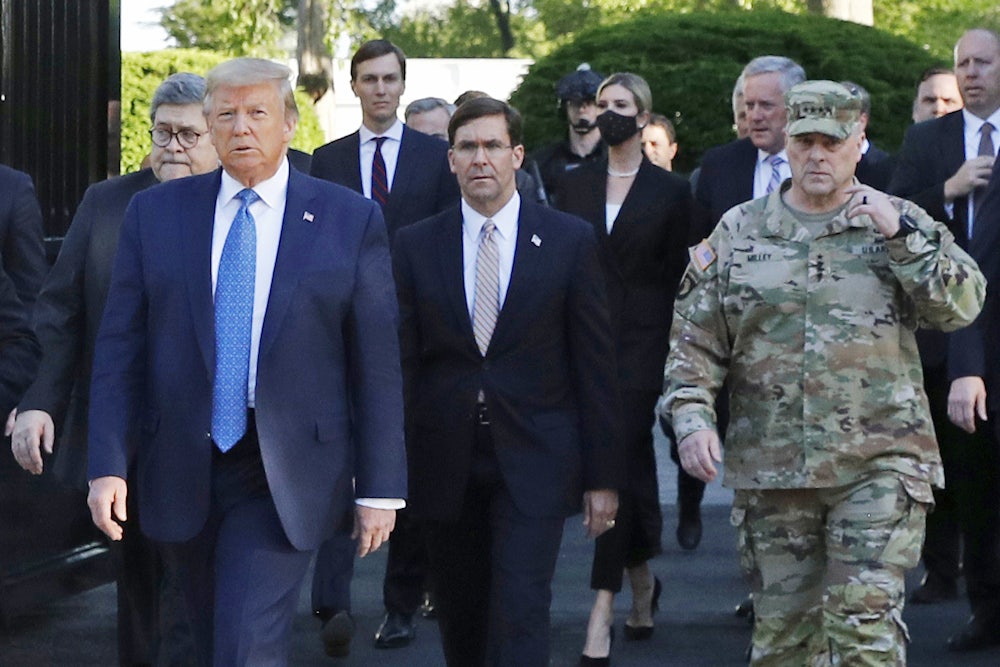Mark Milley is sorry. For the photo op, not the invasion of American streets with soldiers.
Milley—the four-star Army general who, as chairman of the Joint Chiefs of Staff, has made a franchise of slumping in a chair beside the commander in chief with a look of shame—sent reporters and pundits aflutter Thursday when, in a prerecorded video speech for graduates of National Defense University, he apologized for donning his camouflage fatigues and joining Trump on the president’s walk across Lafayette Square last week to pose with a Bible in front of a church, just after federal forces had used tear gas and less-lethal firearm projectiles to attack and repel peaceful demonstrators in the area.
“I should not have been there. My presence in that moment and in that environment created a perception of the military involved in domestic politics,” Milley said in the video, as reported by The New York Times’ Helene Cooper. “As a commissioned uniformed officer, it was a mistake that I have learned from.”
How wonderful it is that 61-year-old generals never stop learning from their mistakes. Milley is trying to be A Better Man, and he is a sight better than Defense Secretary Mark Esper, the West Point grad whose honor code led him to explain away his presence in Trump’s photo op as a misunderstanding: He was just expecting to go “observe” a damaged public bathroom. Esper, in turn, is slightly less greasy than Attorney General Bill Barr, who falsely claimed pepper spray wasn’t a chemical weapon and denied responsibility for the order to violently clear protesters from the square. (“My attitude was, get it done, but I didn’t say, ‘Go do it,’” he said.)
With bosses and colleagues like that, it’s easy to applaud Milley for moral courage of some sort. But the general’s apology covered only his appearance beside Trump, not his own troubling role in the violence and terror carried out in Washington by uniformed, oath-swearing American citizen-soldiers during a dark week that three Times defense reporters—among them an Afghanistan War veteran—called “a debacle for the National Guard.”
That was the debacle that Trump ultimately wanted, after ranting to his military advisers, the nation’s governors, and anyone with a Twitter account about how badly he wanted to use American military might to squash the protests. It pitted undertrained, mostly minority Washington-area National Guard soldiers against their peacefully protesting neighbors and relations.
Milley’s reported role in all this, along with Army Secretary Ryan McCarthy, was to attempt to preserve the Constitution by allowing Trump to set fire to just one small corner of the document. As Trump emerged from his bunker beneath the White House, he clamored for the regular United States Army to cross its own Rubicon into Washington. He was aided in this effort by Republican Senator Tom Cotton and The New York Times editorial page. Milley’s and McCarthy’s subsequent plan to preserve the republic was to show Trump that he didn’t need full-time soldiers to crack skulls; part-time Guard soldiers would do the trick just fine. Early on in the protests, the Times reports, “General Milley and Mr. McCarthy warned the Guard throughout the day that if it could not control the protests, Mr. Trump would most likely call in the 82nd Airborne. The pressure was particularly intense on the D.C. Guard, which had the only sizable military force on the streets.”
Since Trump first repeated the words of the president’s oath, tomes have been written about how intelligent advisers have self-destructed while trying to anticipate or blunt his most childish and fascist caprices. The military establishment has been no exception to this dizzying rule—redirecting Trump’s “Space Force” obsession into a dull bureaucratic reshuffling and whittling down his overseas military withdrawal plans by convincing him he needs to secure Mideast oil. But none of these can remotely touch the spectacle of the U.S. military’s top general and the Army secretary pleading with National Guard leaders to kick ass in what the Times called “a last-ditch attempt to keep active-duty troops outside the city.”
Many of those Guard soldiers on the ground in D.C. understood they were the bad guys, doing bad things: Using low-flying medevac helicopters’ rotor wash as a terrifying crowd-dispersal weapon; operating heavy military vehicles in Washington streets without proper licensing; bombarding nonviolent protesters with gas and rubber bullets. “As a military officer, what I saw was more or less really f---ed up,” one told Politico. “The crowd was loud but peaceful, and at no point did I feel in danger, and I was standing right there in the front of the line. A lot of us are still struggling to process this, but in a lot of ways, I believe I saw civil rights being violated in order for a photo op.”
Now, Milley wants to be forgiven for the photo op. The constitutional crisis, of course, continues unabated and could worsen if Trump decides to fire his top general for having the temerity to be anything more than a mute uniform in the background. But of course Trump loves the troops, which is why, as Milley was busily issuing his mealy-mouthed mea culpa to reporters, the administration was threatening sanctions on any International Criminal Court officer who attempted to prosecute an American service member for war crimes. “We will not stand by as our people are threatened by a kangaroo court,” Secretary of State Mike Pompeo said without any hint of irony in announcing the sanctions on Thursday.
At least Milley knows no court of justice would ever indict him. But with his role in the state violence in Washington this month, he has already firmly established his ultimate legacy, one that should persist long after his green-suited, Trump-adjacent photo appearances are forgotten: He will forever be known as the American general who decided that the main difference between a functional democracy and an unconstitutional junta lies in which uniformed troops you use to beat protesters.
